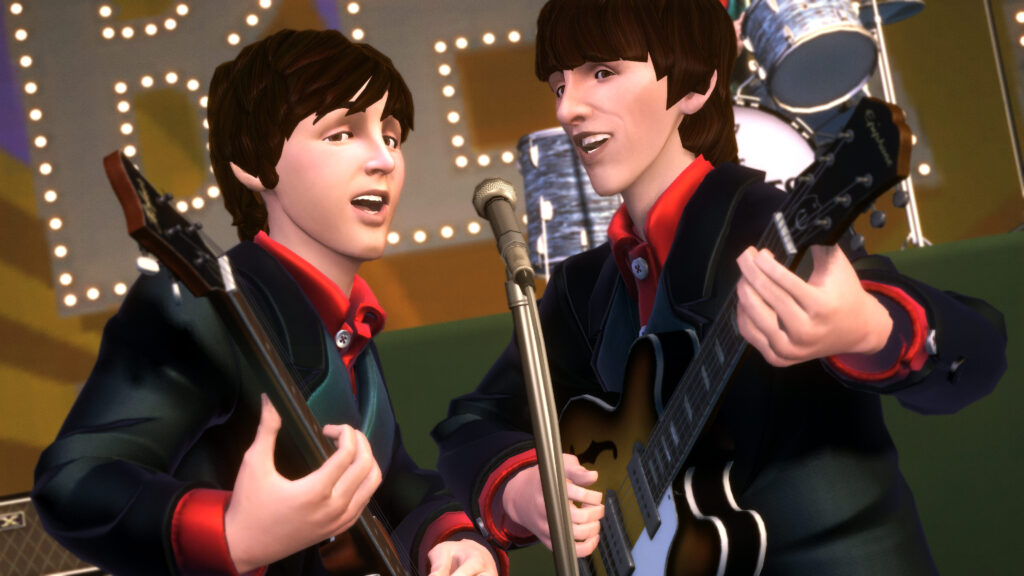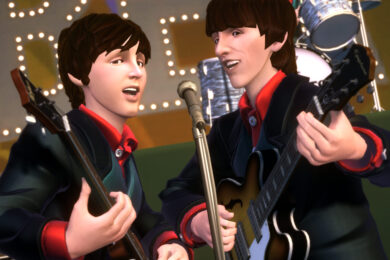October 20th 2009 was the 40th anniversary of the release of The
Beatles’ Abbey Road LP. Though it was originally their penultimate release, before the following year’s Let It Be, it was actually the last thing the band recorded before going their separate ways.
It’s thus interesting to reflect that this final work by the most
successful pop group in history was commemorated by being re-released as downloadable content for a video game alongside the conventional audio release. And even more interesting to note that combined first week sales of the entire remastered Beatles catalogue on CD, vinyl and download were just over a million, while first week sales of The Beatles: Rock Band – which features a mere 45 songs – were close behind at around 700,000.
There’s no arguing with those numbers; videogames are fast becoming a core channel for the release of music. As Beatles: Rock Band audio producer Eric Brosius casually told The Quietus: "The Rock Band series is already a serious album release platform. We’ve put out albums ranging from The Cars to The Pixies’ Doolittle to Guns n’ Roses’ Chinese Democracy [and] two albums (Ten and Backspacer) from Pearl Jam".
The Beatles game has been designed to allow the song list to be
expanded with full albums for download; Abbey Road is to be followed by Sgt. Pepper and Rubber Soul, with other releases still to be confirmed. Sales figures for the Abbey Road release are as yet unknown, but Rock Band‘s development team Harmonix are unquestionably the current kings of the music game hill, their title outselling the rival Guitar Hero 5 by a comfortable margin. It’s a strange rivalry, given that Harmonix actually created Guitar Hero in the first place, but more of that later.
The story of the rise of music in games is, in many ways, also the story of Harmonix, but it’s useful to go back a little further to truly make sense of the phenomenon.
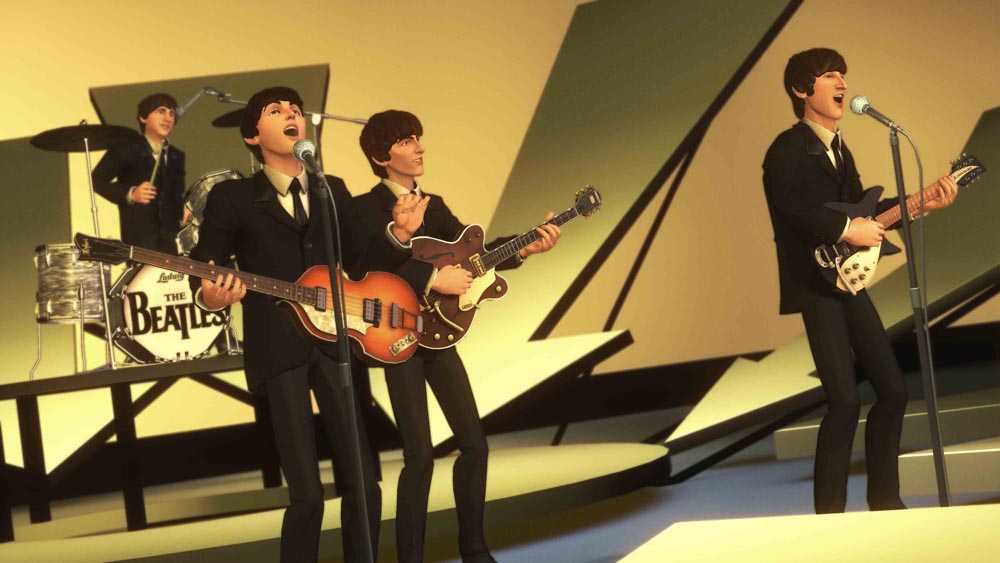
Merseybleep – Music Games In The 80s & 90s
Given the substantial demographic overlap of the video games and music industries – both purveyors of pop culture in exchange for young people’s disposable income – it took a surprisingly long time for them to get into bed together.
For a long time, the barrier was technological. During the first home computer boom in the early 80s, when the rapid rise of synth pop forged a strong cultural link between pop music and videogaming, the computers and consoles of the era possessed incredibly weak sonic capabilities. This collision between the obvious business case on one side, and the spartan engineering constraints on the other, gave rise to some truly odd productions.
The officially licensed Frankie Goes To Hollywood video game took the conceptually bold approach of distilling the
deviant-sex-and-religion-during-the-Cold-War iconography of the band’s ZTT album sleeves into an abstract meander around a strangely deserted rendition of the band’s hometown of – co-incidentally – Liverpool, featuring, um, interpretations of some of the band’s hits.
Developed by fellow Liverpudlians Denton Designs, FGTH was both
bizarre and unfathomable ("Mr. Average is a regular churchgoer… the killer is a vegetarian", ran one of its gnomic pronouncements), but more fatally, it was no fun whatsoever and the music sounded awful. Few other acts seemed willing to surrender their works to such bleepy ignominy, aside from Wham!, who in the same year partnered with Australian publisher Melbourne House to endorse a re-badged version of the company’s Music Box software. This was a music-making application rather than a game, which nonetheless didn’t quite get around the "no fun" problem. Enabling the user to play a whopping two notes at a time, the musical results were hideous.
The only other notable release of the era was a Rocky Horror Picture Show game, which took the Frankie option of marrying an aimless wander of a game to headache-inducing interpretations of the musical’s best-known songs.
After these misadventures, pop music and games spent several years studiously avoiding one another. But by the early nineties, the technology situation had improved to the point where the soundtrack of Rock And Roll racing, featuring songs by the likes of Deep Purple and Black Sabbath, was actually fairly recognisable, as this bracing rendition of Steppenwolf’s ‘Born To Be Wild’ shows:
Unlike the Frankie game’s brave but doomed attempt to reconcile the music’s artistic substance with the game content, Rock And Roll Racing demonstrated the simple appeal of familiarity; just as well-known rock and pop music soundtracks TV sporting events, so could it enhance the gaming experience. Furthermore, the marriage of familiar rock tunes with easily comprehensible rally car gameplay was an early glimpse of how powerful a force licensed music would become in the later mainstreaming of video gaming.
The biggest leap forward in this process was the release of Sony’s PlayStation in December 1994. The videogame industry had previously been dominated by companies that were very much gaming businesses; Nintendo can trace it’s roots back to the 1800s making card and board games, and SEGA (SErvice GAmes) was originally founded in 1940 to provide coin-operated entertainment on US army bases. Until the PlayStation, the two companies enjoyed a stable rivalry sharing the global games console business almost equally between them.
Sony barged their way into the business with two unique advantages; first and foremost, they were a mass consumer electronics company, operating with the full expectation of entering a mainstream market, or even creating one if needs be (as they had with the Walkman in the late 70s). Secondly, they were also a media company, with access to intellectual property in film, television and music – especially music – that other videogame businesses could only dream of. And topping all
this off, their PlayStation eschewed their rivals’ bulky hardware
cartridges, with games instead being loaded from CDs. CDs which could contain the same recordings being sold by the company’s music arm.
None of this would have mattered without appropriate content, though, and the ace up Sony’s sleeve was the game being developed for them by another Liverpudlian firm Psygnosis, who were later to be assimilated into the Sony empire. Psygnosis drew together all these strands of technology, mainstream ambition and licensing muscle in the futuristic race game Wipeout, heavily influenced by contemporary rave aesthetics and featuring tracks by Leftfield, The Chemical Brothers and Orbital.
This made Wipeout immediately the hippest video yet created, and Sony promoted it heavily at festivals and in clubs, often with consoles set up for revellers to play.
After that, the deals came thick and fast. Trent Reznor was contracted to produce original music for seminal first-person shooter Quake, 1998’s Gran Turismo featured tracks from Manic Street Preachers, Ash and Garbage and the annually released Madden NFL series of American Football games became a hotly fought over placement spot for hip hop acts. However, licensed music in games still only made pocket money for the artists and labels concerned; game developers were still borrowing pop music’s credibility, while pop musicians largely still saw games as slumming it a bit. This was all about to change.
Grand Theft Cool
Grand Theft Auto 3 in 2001 took the radical step of featuring only diegetic music; that is, music which emanates from TVs, car radios, nightclubs and so on in the game world itself; the player hears what the characters hear. This was remarkable enough in the early games in the series, which featured specially composed original tracks, but the real breakthrough in commercial terms came with 2002’s Grand Theft Auto: Vice City. Set in a fictionalised Miami in the mid-80s, the game featured around a hundred tracks of astutely chosen authentic period music, including Afrika Bambaataa, Michael Jackson, the aforementioned Frankie, Motley Crue and other luminaries of the era.
The effect of this on the play experience was remarkable enough –
flying through the air in slow motion on a motorbike, wearing a pastel suit and spraying an AK-47, as Kate Bush’s ‘Wow’ ululates in the background is a truly unique experience – but more significant from the music industry’s point of view was the popularity of the seven disc soundtrack box-set, bringing real profile and real sales volume to some dusty portions of the record labels’ back catalogues. The game itself had sold some 12 million copies in its first wave, giving huge exposure to the artists featured. Crucially, for the first time, many of these records were borrowing GTA‘s hipness, rather than the reverse. So suddenly, placing artists’ music in games – the right games – was as important as placing it in film and television.
However, at this stage, game music was still largely used in a
movie-like, soundtrack fashion, not as the core of the interactive experience, which is where Harmonix come in.
From M.I.T. To Karaoke
Engineer Eran Egozy and music composition major Alex Rigopulos had met working in the M.I.T. Media Lab in the mid-90s. Adapting one of the lab’s projects – a computer program that could algorithmically generate original music in real time – into a game-like joystick controlled interactive experience, triggered a fascination with putting the experience of performing music into the hands of non-musicians, which has remained Harmonix’s mission statement from its foundation to the present day.
One of their earlier works, CamJam, which tracked players’ body
movements in order to generate music was taken up in Disney theme
parks. But a visit to Japan, where they had hoped the game would be a sure fire hit due to the emerging fad for Karaoke and dance-mat based games, showed them they were barking up the wrong tree. The fun of Karaoke, they realised, was not in trying to create new music, but rather in trying to nail a performance of existing pieces of music; in other words, the players were more interested in acting out a performance, rather than dealing with the complexities of music creation.
Armed with this knowledge, and exploiting the fact that Harmonix had made some canny hiring choices from the Boston music scene, including members of the bands Freezepop and The Acro-Brats, they set to work on FreQuency, which is just about recognisable as an ancestor of Guitar Hero.
Released in 2001, FreQuency was a huge critical success, but was simply too abstract and strange to become the mainstream hit Egozy and Rigopulos felt was within reach. Furthermore, despite bagging a handful of licensed tracks, the moment was not quite right; Harmonix themselves didn’t have the financial muscle to pull in much licensed content, and the impact of Vice City had not yet been fully felt; record labels were still eyeing the games industry with at best suspicion and at worst outright derision. File-sharing was still new and as yet hadn’t eaten all that much of the music industry’s lunch. And cool as they were, FreQuency‘s tracks from The Jungle Brothers and Meat Beat Manifesto simply were not enough to drive the game into the mass consciousness.
A sequel, Amplitude, was released in 2003, with a more populist (if US-centric) soundtrack featuring Slipknot, Garbage and Blink-182, again to great reviews, but the overall experience remained too perplexing and geeky to really break through.
It was the input of two external companies that was to prove
Harmonix’s turning point. Approached by Japanese publisher Konami to create the Karaoke Revolution series for the US market, Harmonix began to greatly simplify their approach. Under Konami’s guidance the trippy visuals and semi-underground soundtrack were dropped in favour of a clear representation of a Karaoke bar with identifiably human player avatars, virtual whooping and heckling crowds, and shamelessly wedding disco song choices. Suddenly, here was a game non-gamers could understand and play.
Released in 2003, Karaoke Revolution was wildly more successful than anything Harmonix had released to date. Rigopulos, however, recently confessed in an interview with CNN that he "got really gloomy" at this time. He felt that the Karaoke games were "less compelling" than the previous titles, and the company’s one attempt to move out of the music game area, EyeToy: AntiGrav was critically reviled, despite it’s strong sales.
Out of the blue, a small gaming peripherals company, Red Octane,
approached Harmonix with a prototype of a plastic guitar-shaped
controller, but little idea what to do with it. Producing a game that required special hardware to play was, in those pre-Wii Fit days, seen as a huge risk. But, Egozy says, "it was the game we always wanted to make".
Guitar Hero – Music Gaming Goes Overground
Guitar Hero blended the instantly comprehensible gameplay and cheesy pop appeal of the Karaoke and dance-mat games with a significantly lower embarrassment threshold. Suddenly you didn’t have to actually sing and dance, often to slightly camp pop; you could simply stand and rock out to Bon Jovi with your plastic Gibson SG. This gave the game a more even gender split than its predecessors; the Karaoke games had skewed very female, and FreQuency was the very epitome of a nerdy boys’ toy. Cross-demographic "party" appeal is one of the game’s industry’s oft-elusive holy grails, and Guitar Hero absolutely
nailed it like nothing before.
Still, the huge success of the series seems to have been
unanticipated. The music tracks in the first game in the series were re-recorded cover versions, in order to keep costs down and reduce the complexity of the licensing deals. However, $45 million worth of sales later, record labels and their biggest acts were scrambling over one another to be featured in the series. Ex-Guns N Roses guitarist Slash even donned a motion capture suit to play the starring role in Guitar Hero III, which went on to be the first video game in history to rake in over $1 billion at retail. Guitar Hero III was later expanded into Guitar Hero: Aerosmith, featuring 29 songs from the band themselves, and sneaking in another dozen or so from "related" acts, including some much-needed exposure for lead guitarist Joe Perry’s solo album.
However, by this time, Harmonix had moved on. The details are murky, and mostly nobody is talking, but a huge bidding war erupted over the franchise, and there was something of a tug of war between the music and games industries. When the smoke had cleared, global games publisher Activision had bagged Red Octane, makers of the guitar peripheral and holders of the Guitar Hero publishing rights for $100m, and MTV had bought out Harmonix, developers of the actual games themselves, for closer to $150m.
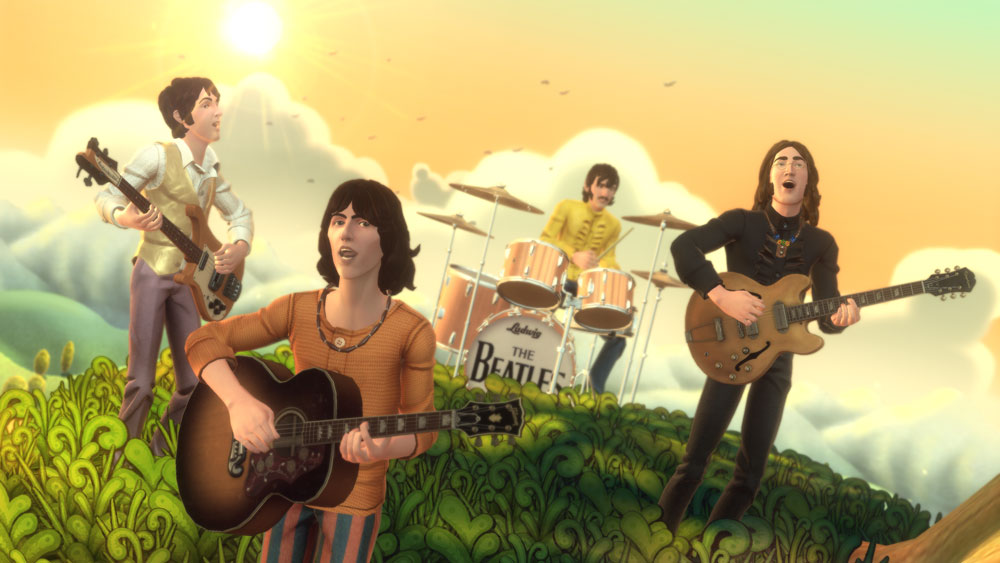
This success brought with it the inevitable hell-in-a-handbasket
proclamations, with the accusation frequently levelled that Guitar Hero was a nefarious influence, that would ensure no child would ever pick up a real instrument again.
"Yeah, I think I’ve heard that comment once or twice," Josh Randall, creative director of the Beatles game dryly notes. "Our experience has actually been just the opposite. Going as far back as FreQuency, I’ve been getting letters from fans saying they played our games, and now have decided to take up real instruments. Even though we don’t necessary teach people how to play instruments, I think our games can sometimes introduce certain kinds of people to their inner musician. Sometimes that spark ignites into a passion for playing a real instrument."
Rock Band – Battle Of The Brands
The amount of seriously hard cash flying around at this point was
enough to make anyone’s head spin, and with the music industry facing declining revenues just as that of games was becoming stratospheric, the battle to become – and more importantly own – the platform of choice for music in games was well and truly joined. Harmonix set about the creation of Rock Band, adding a plastic drum kit and a microphone to the instrument line up, and more crucially, designing the platform from the ground up to allow in game purchases of additional songs.
It’s hard to overstate the significance of this to a music industry in a panic over file-sharing piracy. These games and the consoles they are played on are closed systems; the downloaded content cannot be easily copied or shared in the way a simple mp3 file can. Meaning every player is also a payer.
Guitar Hero quickly duplicated the
multiple-instruments-and-downloads approach, and with so little real difference between the two platforms (the instrument peripherals were largely interchangeable between the two games), the real duel was all about content. For record labels, cross platform exposure is ideal, but for the game developers, exclusive tie-ins that promote their platform above their rivals’ are essential.
Metallica, whose previously most notable foray into the new dawn of digital distribution had been to sue their own fans for downloading tracks from Napster, signed up with Guitar Hero. Initially releasing their Death Magnetic album as downloadable game content for Guitar Hero III simultaneously with the CD release, they went on to feature in the second single-band game of the series. Repeating the Aerosmith gambit of piggybacking some lesser acts onto a known box-office draw, Metallica also slipped on the motion capture wetsuits and threw shapes for digital posterity.
For a few short weeks, it seemed that Activision had won the war;
Metallica are one of the few truly global stadium bands, with the same kind of sell-out-everywhere pulling power of U2. Then Harmonix / MTV announced the surely-this-is-an-April-Fool’s-stunt Beatles deal.
The Beatles’ obsessively tight control of their catalogue and image rights is well known. Josh Randall comments: "Making a videogame tribute to the most influential rock band of all time was certainly intimidating. We knew we had to get it right, so we spent a ton of long hours on the details." However, he adds, "the entire Apple Corps team just sort of got it. They were excited about the idea of getting people musically engaged in a new interactive way".
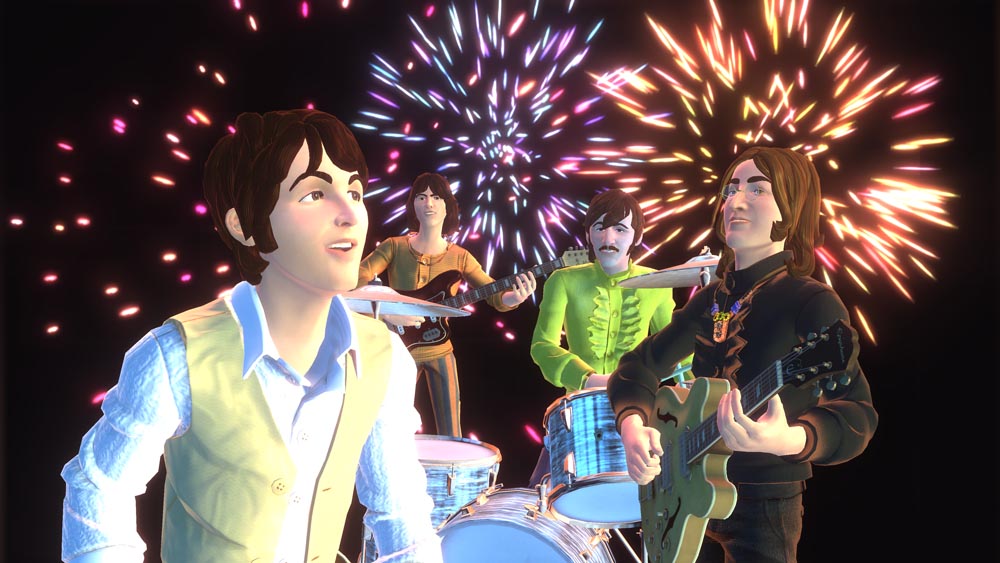
All You Need Is Contacts
The title’s genesis highlights the significance of the MTV deal.
George Harrison’s son Dhani happened to get chatting to MTV
vice-president Van Toffler shortly after the Harmonix acquisition, which is the kind of connection no amount of Activision’s money could buy. Harrison was already familiar with Guitar Hero and floated the possibility of Beatles game, which even he apparently though was an unlikely prospect. Nonetheless, he set about discussing possible approaches with Rigopolus and persuading the two surviving Beatles, Yoko Ono and Olivia Harrison, who jointly control the Beatles’ rights, that this was worth looking into. Eventually, Harmonix produced a five-song demo version of the game, which convinced the quartet to come aboard.
There’s little question that Beatles: Rock Band represents the
current state of the art of the form, with several key enhancements from standard Rock Band. "The biggest game play difference is the inclusion of vocal harmonies", says audio director Eric Brosius. "When we first started digging deeper into the music of The Beatles, it quickly became apparent that we would need to incorporate their rich vocal harmonies. Our code and design team worked out a way to incorporate three-part harmony as a game element allowing up to six people to play together, singing in harmony". It’s hard to describe just how giddying an experience this is to anyone who hasn’t played
the game with a large group.
Also, despite the huge financial success of the genre that Harmonix kick-started, it would be impossible to accuse them of cynically following the money. Their story is one of waywardly following their own interests, often flying in the face of commercial good sense, so somewhere under the multi-million dollar deals, it’s all rather heart-warming; what could be more pop music than a bunch of eccentrics with a weird idea making it big?
On the other hand, the criticism could be levelled that the newer
single-band, demographically narrow editions of these games are
straying away from the populist office party appeal of the earlier iterations. In the earlier games, if you didn’t like the current song, you only had a few minutes to wait for something else. In Beatles: Rock Band, if you don’t like The Beatles, you’re in for a fairly alienating experience. Also, where the "various artists" editions happily revel in Karaoke-like silliness, the single band titles are necessarily more reverent.
The aesthetic of Beatles: Rock Band is a beautifully realised
extension of the band’s different phases. "It was crucial not to
simply dump The Beatles into Rock Band," says lead artist Dare
Matheson, and the attention to detail is indeed astonishing. From
their suited-up mod cool of the early 60s, to the psychedelic
dreamscapes of Sgt. Pepper to the hairy proto-heavy rockers of their White Album period, the visualisations of each band member are rigorously period accurate. Whether all that’s anywhere near as much fun as getting your user-customised rock star avatar to crank out Black Sabbath’s ‘Paranoid’ in Rock Band 1 was, though, is a question for the individual player, but there’s little doubt as to which go down better if you get everyone back to your place after the pub.
That said, the strategy is clearly to create and control different demographic channels. With an eye to full spectrum dominance, MTV/Harmonix have also just released Lego Rock Band, aimed at the kid / family market, featuring cutesified plastic figures of the likes of Iggy Pop, David Bowie and Queen.
Another closed system, the game only allows the download of songs
deemed appropriate for minors, and features child-friendly difficulty settings (such as not requiring the use of the bass drum pedal for children too small to reach it).
Activision are heading in a different direction, diversifying into the parallell DJ Hero series, which comes with a pair of turntable style controllers and a playlist leaning towards hip-hop and electronica.
Between all these variants on the same core idea, the music industry has been delivered a set of tightly copy protected distribution channels, with hitherto unknown levels of demographic focus. While there are some rumblings that the public appetite for music play-along games may be waning (sales of both Guitar Hero 5 and Beatles Rock Band have been slightly slower than expected), it seems unlikely that either the game developers or the record labels are going to be abandoning such a vigorously lactating cash cow any time soon.
The latest game in the Grand Theft Auto series, The Ballad Of Gay Tony, makes the marriage of the two industries explicit. The player controls Luis Lopez, co-owner of a pair of Manhattan nightclubs, and the very first thing that happens in the game is that you go to one of your clubs and dance.
The in-game mobile phone’s Shazam-like feature allows you to look up the artist and title of any track playing in the game, and gives you a handy link to buy it from the real-world Amazon store. And said track might well be Busta Rhymes’s single Respect My Conglomerate, initially released exclusively via GTA, because, as the song says "I be gettin’ paid, like outta this world".
In 2008, sales of video games globally outgrew both film and music (though not both combined as some sources erroneously reported). Where this is all headed is anyone’s guess, but any young bands signing a recording contract should probably look even more carefully at their video game royalty deal than their CD deal. As the eponymous club owner in The Ballad Of Gay Tony cheekily meta-comments: "Like anyone buys CDs any more…"

